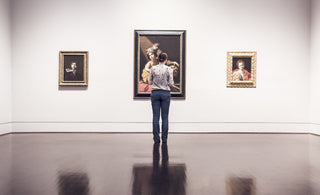
The act of investing in and collecting art has been rapidly rising in popularity over the years, with more and more people looking to invest in art than ever before on a global scale.
With the increase in art collectors and avid art buyers comes the demand for a good art advisor to help them along their art-buying journey. In this article, we are going to explain what an art advisor is and how you can benefit from having one, along with the difference between an art advisor and an art dealer.
What Is an Art Advisor?
An advisor with ample knowledge of the art market is a professional who helps art collectors and investors find the right pieces to suit their budgets and needs.
A great art advisor can help with art acquisitions and be an art consultant for those with private collections, while also being well-versed enough to be able to offer valuable art investment advice and top tips on building an art collection.
What Does an Art Advisor Do?
The role of an art advisor can differ slightly depending on the type of client they are working with. Take private collectors, for example. With private collectors, art advisors will often be the curators and will help the client by offering them pieces that fit their personal tastes or interests when it comes to art.
Art advisors can also help by advising on the framing, lighting, and conditions in which to store the artwork for the perfect storage and display solutions. For those looking for some serious art investments, art advisors can advise on what art to purchase and when to purchase it for the maximum profits to be made.
Many art advisors will have a type of art that they specialise in. Therefore, you need to be matched with the right type of advisor who can meet your needs specifically and help you with what you are looking for while accommodating your art tastes.
How Can I Benefit From an Art Advisor?
You will benefit from having an art advisor if you want to invest in or purchase art. This is because the art market and the art world can be difficult to navigate, so having an expert in the art field by your side can help you when making important investment decisions. Similar to having a financial advisor help you by advising you on what to invest your money in, an art advisor can do the same, but concerning art.
From the information your art advisor has given you, you can make an informed and confident choice about what art you want to invest in. You may be interested in contemporary art, rare art, blue chip artists, or up-and-coming artists, and therefore, acquiring art with the help of an art advisor who specialises in one of these fields can help you.
Whatever you are after, buying and collecting art is an enjoyable experience. Having an art advisor to help you along the way can help you with your journey of investing in art and adding to your collection. Ultimately, an art advisor can tell you everything you need to know about investing in art.
Art Advisor vs Art Dealer: What’s the Difference?
Both art advisors and art dealers have to be art experts and have extensive knowledge of art history. An art dealer has a responsibility to represent the artist’s work. When the art dealer manages to sell the artist’s work, they will take a percentage of the sale price of the art piece; this can range anywhere between 20% and 40% of the final price.
An art advisor works for clients, providing them with all the information they need on the art they are interested in and giving them neutral advice and guidance on the process of acquiring pieces that fit the collection they want to build.
The key takeaway to understanding the difference between an art advisor and an art dealer is that, while they both have the expertise that allows them to help someone create a collection of art, the fee structure is different for each.
An advisor and a dealer are compensated from different sides. The fee for an art dealer comes from the sale of the artwork, whereas an art advisor’s fee comes from the paying client.
An Art Advisor’s Process
When identifying an art advisor to help you with buying art, there are likely to be the following main steps to the process:
Consultation
Your art advisor will need to discuss what you hope to achieve from working with them and how you wish to add to or build your art collection. In this stage, your advisor will learn more about your tastes and the type of art you like.
Research
Your art advisor will research all suitable artwork available for you once they have gotten to know your needs. They will look at art in galleries, art fairs, and art auction houses too. Art advisors have a lot of contacts and a great network of artists and dealers to find their clients the perfect pieces of artwork that are specifically great for their tastes and budget.
Presentation
Upon finding art that is suitable for their client, art advisors will present it to you in the form of an art proposal. You, as the client, will be able to ask any questions about the artwork at this stage.
Final Decision and Acquisition
You will be able to make the final decision about the artwork your advisor has found, deciding whether or not to purchase any art pieces. Art advisors can help negotiate a fair price for you. They can also help with the framing of the art, handling, and shipment.
How Grove Gallery Can Help
Grove Gallery can help you if you need an art advisor. We are a trusted London art gallery with experience working with clients from across the globe. We have dedicated advisors ready and waiting to help you with your art investing journey.
Art advisors are an indispensable tool that any art buyer should take advantage of if they are serious about creating the perfect and most worthwhile collection. Using an art advisor’s guidance will help to enhance your home with art and enrich your future investments and finances.
Whoever you are, whatever your background is, or whatever your experience with art is, we are open and willing to help. Whether you are an art collector or investor, we can help you all year round, so get in touch with us at Grove Gallery today.






